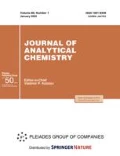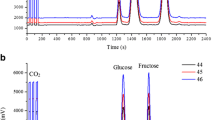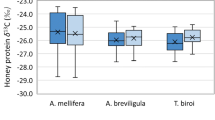Abstract
A procedure is proposed for determining the quality of honey by measuring the isotope composition of carbon in the initial honey samples and their protein fractions by mass spectrometry. Seventeen samples of honey harvested in 2014 in various regions of Russia were investigated to identify falsifications with sugars or invert syrups. Using the data on the isotope ratios of δ13C of initial honey samples and protein fractions, the degree of adulteration of the test honey samples was determined. Concentration of sugar was used as a criterion of adulteration. According to the data obtained, in two samples of honey, the difference between the δ13C values in the protein fraction and the original honey was more than 1‰, indicating the dilution of these honey samples with cane sugar by more than 7%. It is shown that the isotope composition of honey is not only informative for detecting the adulteration of honey, but also can serve as a kind of marker for the geographical origin of honey.
Similar content being viewed by others
References
Arinkina, A.I., Khimicheskii sostav i svoistva pchelinogo meda i ikh izmenenie posle nagrevaniya (Chemical Composition and Properties of Honey and Their Change after Heating), Moscow: Tsentr. Inst. Nauchn.-Tekh. Inf. Pishevoi Prom-ti, 1971.
Frew, R., McComb, K., Croudis, L., Clark, D., and Van Hale, R., Food Chem., 2013, vol. 141, p. 4127.
Çinar, S.B., Ekşi, A., and Coşkun, I., Food Chem., 2014, vol. 157, p. 10.
Cienfuegos, E., Casar, I., and Morales, P., J. Apic. Res., 1997, vol. 36, nos. 3–4, p. 169.
Cengiz, M.F., Durak, M.Z., and Ozturk, M., Food Sci. Technol., 2014, vol. 57, no. 1, p. 9.
Nikitina, V.A., Pchelovodstvo, 1995, no. 1, p. 20.
Talibova, A.G. and Kolesnov, A.Yu., Analitika, 2011, no. 1, p. 44.
Galimov, E.M., Priroda biologicheskogo fraktsionirovaniya izotopov (Nature of Biological Isotope Fractionation), Moscow: Nauka, 1981.
Kolesnov, A.Yu., Moiseyak, M.B., and Talibova, A.G., Sakhar, 2011, no. 8, p. 39.
Chesson, L., Tipple, B.J., Erkkila, B.R., and Ehleringer, J.R., Food Chem., 2011, vol. 125, p. 576.
Author information
Authors and Affiliations
Corresponding author
Additional information
Original Russian Text © O.V. Vetrova, D.A. Kalashnikova, V.N. Melkov, G.V. Simonova, 2017, published in Zhurnal Analiticheskoi Khimii, 2017, Vol. 72, No. 7, pp. 645–649.
Rights and permissions
About this article
Cite this article
Vetrova, O.V., Kalashnikova, D.A., Melkov, V.N. et al. Detection of honey adulterations with sugar syrups by stable isotope mass spectrometry. J Anal Chem 72, 756–760 (2017). https://doi.org/10.1134/S1061934817070152
Received:
Accepted:
Published:
Issue Date:
DOI: https://doi.org/10.1134/S1061934817070152




